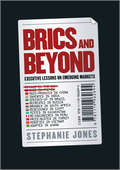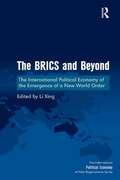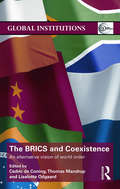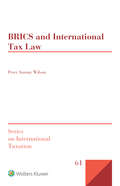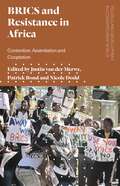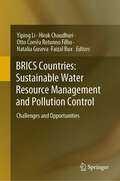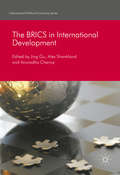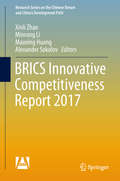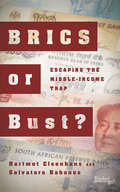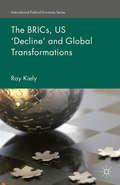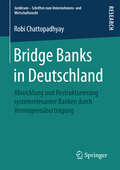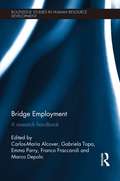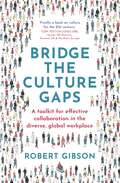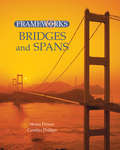- Table View
- List View
The BRICS: A Very Short Introduction (Very Short Introductions)
by Andrew F. CooperIn the wake of the post-Cold War era, the aftermath of 9/11, the 2008 global financial crisis, and the emergence of the G20 at the leaders level, few commentators expected a reshaping of the global system towards multipolarity, and away from the United States. And yet, the BRICS - encompassing Brazil, Russia, India, China and South Africa - has emerged as a challenge to the international status quo. But what is its capacity as a transformative force? And can it provide a significant counter-narrative to the Western dominated global order? In this Very Short Introduction Andrew Cooper explores the emergence of the BRICS as a concept. Drawing on historical precedent, Cooper provides a contemporary analysis of the BRICS' practice and influence as as a forum and a lobby group in advancing a distinctive but amorphous agenda amongst global politics. ABOUT THE SERIES: The Very Short Introductions series from Oxford University Press contains hundreds of titles in almost every subject area. These pocket-sized books are the perfect way to get ahead in a new subject quickly. Our expert authors combine facts, analysis, perspective, new ideas, and enthusiasm to make interesting and challenging topics highly readable.
The BRICS: A Very Short Introduction (Very Short Introductions)
by Andrew F. CooperIn the wake of the post-Cold War era, the aftermath of 9/11, the 2008 global financial crisis, and the emergence of the G20 at the leaders level, few commentators expected a reshaping of the global system towards multipolarity, and away from the United States. And yet, the BRICS - encompassing Brazil, Russia, India, China and South Africa - has emerged as a challenge to the international status quo. But what is its capacity as a transformative force? And can it provide a significant counter-narrative to the Western dominated global order? In this Very Short Introduction Andrew Cooper explores the emergence of the BRICS as a concept. Drawing on historical precedent, Cooper provides a contemporary analysis of the BRICS' practice and influence as as a forum and a lobby group in advancing a distinctive but amorphous agenda amongst global politics. ABOUT THE SERIES: The Very Short Introductions series from Oxford University Press contains hundreds of titles in almost every subject area. These pocket-sized books are the perfect way to get ahead in a new subject quickly. Our expert authors combine facts, analysis, perspective, new ideas, and enthusiasm to make interesting and challenging topics highly readable.
BRICs and Beyond: Lessons on Emerging Markets
by Stephanie JonesBRICs and Beyond is an international business executive text written especially for executive and MBA students. It is based on extensive consulting in emerging economies and several years of experience teaching executive MBA courses around the globe. The author has continually faced the problem that the available textbooks for teaching international business focused almost exclusively on examples of Western multinationals for case illustrations. In the process of preparing cases nearer to the emerging market she worked in, the author realized that the often fascinating, frequently insightful and always different approach to business illustrated by these cases should be required reading for MBA students in typical Western environments too. With its wide range of current case illustrations and concise summaries this is a new-generation text that will welcome today's MBA student to the wider world of 21st century international business. ". . . this book is needed not only because it looks at business from the BRICs points of view; it also looks at business from the point of view of tomorrow's business leaders and the challenges that they will have to cope with." --Professor Jonathan Gosling, Centre for Leadership Studies, and co-founder, The One-Planet MBA, the University of Exeter, UK ". . . Stephanie Jones advises Western businesses on doing business in emerging economies in a refreshingly straightforward manner, integrating in a novel way her three decades of global, practical experience with the daily barrage of reporting on the BRICs--distilling from these many lessons and principles. . ." --Extracted from the Foreword, by Professor Wim Naudé, Director of Research, Maastricht School of Management
BRICs and Beyond: Lessons on Emerging Markets
by Stephanie JonesBRICs and Beyond is an international business executive text written especially for executive and MBA students. It is based on extensive consulting in emerging economies and several years of experience teaching executive MBA courses around the globe. The author has continually faced the problem that the available textbooks for teaching international business focused almost exclusively on examples of Western multinationals for case illustrations. In the process of preparing cases nearer to the emerging market she worked in, the author realized that the often fascinating, frequently insightful and always different approach to business illustrated by these cases should be required reading for MBA students in typical Western environments too. With its wide range of current case illustrations and concise summaries this is a new-generation text that will welcome today's MBA student to the wider world of 21st century international business. ". . . this book is needed not only because it looks at business from the BRICs points of view; it also looks at business from the point of view of tomorrow's business leaders and the challenges that they will have to cope with." --Professor Jonathan Gosling, Centre for Leadership Studies, and co-founder, The One-Planet MBA, the University of Exeter, UK ". . . Stephanie Jones advises Western businesses on doing business in emerging economies in a refreshingly straightforward manner, integrating in a novel way her three decades of global, practical experience with the daily barrage of reporting on the BRICs--distilling from these many lessons and principles. . ." --Extracted from the Foreword, by Professor Wim Naudé, Director of Research, Maastricht School of Management
The BRICS and Beyond: The International Political Economy of the Emergence of a New World Order (The International Political Economy of New Regionalisms Series)
by Li XingThe world is in an era of great transformations. Globalization, transnational capitalism, September 11, the 2008 global financial crises, and the emergence of the ’second world’ in general and the BRICS in particular are characterized by a diffusion of power away from the traditional North Western powers and towards the global South. Such great transformations have reshaped the terrain and parameters of social, economic and political relations both at the national and the global levels and have exerted pressure on the exiting international order in terms of both opportunities and constraints. This new era also urges the need for re-conceptualizing the changing world order especially with regard to one of the core conceptual categories and analytical apparatus in the studies of IR and IPE - hegemony. The world will witness a new era of interdependent hegemony, in which both the existing ’First World’ and the emerging ’Second World’ are intertwined in a constant process of shaping and reshaping the international order in the nexus of national interest, regional orientation, common economic and political agenda, political alliance and potential conflicts. This collection juxtaposes, from different perspectives and approaches, the discussion on the political economy of the emerging world order with a focus on the rising powers.
The BRICS and Beyond: The International Political Economy of the Emergence of a New World Order (The International Political Economy of New Regionalisms Series)
by Li XingThe world is in an era of great transformations. Globalization, transnational capitalism, September 11, the 2008 global financial crises, and the emergence of the ’second world’ in general and the BRICS in particular are characterized by a diffusion of power away from the traditional North Western powers and towards the global South. Such great transformations have reshaped the terrain and parameters of social, economic and political relations both at the national and the global levels and have exerted pressure on the exiting international order in terms of both opportunities and constraints. This new era also urges the need for re-conceptualizing the changing world order especially with regard to one of the core conceptual categories and analytical apparatus in the studies of IR and IPE - hegemony. The world will witness a new era of interdependent hegemony, in which both the existing ’First World’ and the emerging ’Second World’ are intertwined in a constant process of shaping and reshaping the international order in the nexus of national interest, regional orientation, common economic and political agenda, political alliance and potential conflicts. This collection juxtaposes, from different perspectives and approaches, the discussion on the political economy of the emerging world order with a focus on the rising powers.
The BRICS and Coexistence: An Alternative Vision of World Order (Global Institutions)
by Cedric De Coning Thomas Mandrup Liselotte OdgaardThe grouping consisting of Brazil, Russia, India and China (BRIC) was initially meant to be nothing more than clever investment jargon referring to the largest and most attractive emerging economies. However, these countries identified with the BRIC concept, and started to meet annually as a group in 2008. At their fourth summit in 2011, they added South Africa to become the BRICS. By then the BRICS had fully morphed from investment jargon to a name for a new economic and political grouping that had the potential to challenge the unipolar hegemony of the United States and its Western allies. This work analyses the extent to which the concept of coexistence explains the individual foreign policies of the BRICS countries. The editors define coexistence as a strategy that promotes the establishment of a rule-based system for co-managing the global order. It recognizes that different states may legitimately pursue their own political and economic interests, but they have to do so within the bounds of a rule-based international system that ensures the peaceful coexistence of states. The BRICS and Coexistence addresses the political dimension of the emergence and influence of the BRICS in the international system and will be of interest to students and scholars of Politics, Development and International Relations.
The BRICS and Coexistence: An Alternative Vision of World Order (Global Institutions)
by Cedric De Coning Thomas Mandrup Liselotte OdgaardThe grouping consisting of Brazil, Russia, India and China (BRIC) was initially meant to be nothing more than clever investment jargon referring to the largest and most attractive emerging economies. However, these countries identified with the BRIC concept, and started to meet annually as a group in 2008. At their fourth summit in 2011, they added South Africa to become the BRICS. By then the BRICS had fully morphed from investment jargon to a name for a new economic and political grouping that had the potential to challenge the unipolar hegemony of the United States and its Western allies. This work analyses the extent to which the concept of coexistence explains the individual foreign policies of the BRICS countries. The editors define coexistence as a strategy that promotes the establishment of a rule-based system for co-managing the global order. It recognizes that different states may legitimately pursue their own political and economic interests, but they have to do so within the bounds of a rule-based international system that ensures the peaceful coexistence of states. The BRICS and Coexistence addresses the political dimension of the emergence and influence of the BRICS in the international system and will be of interest to students and scholars of Politics, Development and International Relations.
BRICS and International Tax Law
by Peter Antony WilsonWith the ongoing expansion of outbound foreign direct investment (FDI) in the countries representing the BRICS economic bloc (Brazil, Russia, India, China, and South Africa) – and with all of them at the same time listed among the top seven countries plagued by tax evasion and avoidance in the guise of illicit out ows – the ve governments, both individually and through cooperative initiatives, have devised new international tax strategies that are proving to be of great interest and value to other countries, both developing and developed. The core of these strategies addresses the necessity of stemming the out ow of revenue while strongly supporting FDI, both inbound and outbound while complying with international obligations including those arising from human rights laws. This book is the rst in-depth commentary on this new and evolving area of international tax law. The detailed analysis covers the entire eld of BRICS international tax law, considering topics such as the following: – information exchange procedures and pitfalls; – response to the OECD’s Base Erosion and Pro t-Sharing (BEPS) initiative; – role of bilateral and multilateral double taxation conventions including the Multilateral Instrument and the Bilateral Investment Treaties; – thin capitalization; – transfer pricing; – controlled foreign corporation rules; – shortcomings related to authorities’ limited manpower; – international audit and investigation procedures; – the BRICS approach to residence and mandatory and binding arbitration; and – the BRICS approach to shaping the developing world’s international tax system. Notably, the author personally conducted interviews with senior international representatives of the BRICS tax authorities, as well as with leading BRICS academics and practitioners. Tax cases, together with human rights and investment cases and administrative guidelines in all ve countries are also included in the analysis. The study concludes with recommendations for improving each of the ve countries’ tax law and procedures, especially in the area of dispute resolution. The author’s goal is to extend the existing body of knowledge of the BRICS’ international tax laws in order to assist in developing an understanding of the BRICS approach to dealing with evasion and avoidance: an approach which facilitates both outbound and inbound FDI, simpli es tax authority administration and establishes a basis for resolving international disputes which is compatible with sovereignty. In achieving this objective, the author has produced a major work that is of immeasurable value to tax advisers, government and governance of cials, academics and researchers both in developing international taxation strategies and in helping to resolve disputes with tax authorities.
BRICS and Resistance in Africa: Contention, Assimilation and Co-optation (Politics and Development in Contemporary Africa)
by Justin van der Merwe Patrick Bond Nicole DoddThough initially considered a welcome counterweight to Western interest across Africa, the BRICS are increasingly being viewed as another example of foreign interference and exploitation.BRICS and Resistance in Africa explores the varied forms of African resistance being developed in response to the growing influence of the BRICS. Its case studies cover such instances as the opposition to China's One Belt One Road initiative in East Africa; resistance to the BRICS' oil activities in the Niger Delta; and the role of the BRICS in Zimbabwe's political transition. The contributors expose the contradictions between the group's rhetoric and its real impact, as well as the complicity of local elites in serving as proxies for the BRICS nations.By challenging and expanding the debates surrounding BRICS involvement in Africa, this collection offers new insight into resistance to globalization in the global South.
BRICS and Resistance in Africa: Contention, Assimilation and Co-optation (Politics and Development in Contemporary Africa)
by Justin Van Der Merwe Patrick Bond Nicole DoddThough initially considered a welcome counterweight to Western interest across Africa, the BRICS are increasingly being viewed as another example of foreign interference and exploitation.BRICS and Resistance in Africa explores the varied forms of African resistance being developed in response to the growing influence of the BRICS. Its case studies cover such instances as the opposition to China's One Belt One Road initiative in East Africa; resistance to the BRICS' oil activities in the Niger Delta; and the role of the BRICS in Zimbabwe's political transition. The contributors expose the contradictions between the group's rhetoric and its real impact, as well as the complicity of local elites in serving as proxies for the BRICS nations.By challenging and expanding the debates surrounding BRICS involvement in Africa, this collection offers new insight into resistance to globalization in the global South.
BRICS Countries: Challenges and Opportunities
by Yiping Li Hirok Chaudhuri Otto Corrêa Rotunno Filho Natalia Guseva Faizal BuxThis book provides a detailed study and assessment of water resources management andpollution control in different BRICS countries. The regions involved areBrazil, Russia, India, China and South Africa. This book gives importantinsight into how future sustainability depends on the development of effectivewater governance mechanisms at the level of countries. According to theregional characteristics from different aspects it cuts into the waterenvironment problems and studies in different ways, which is multifaceted andtargeted. Using case studies that include environmentally integrated basinexperiments (eibex) of Brazil, groundwater overflow zone of India, semi-aridriver basin of South Africa and so on, this volume provides criticalinformation for researchers and policymakers.
The BRICS in International Development (International Political Economy Series)
by Jing Gu Alex Shankland Anuradha ChenoyThis book offers a comprehensive comparative perspective on the increasingly significant development cooperation activities of the BRICS. Providing a powerful set of insights into the drivers for engagement within each country, it brings together leading experts from Brazil, Russia, India, China, South Africa and OECD countries. The authors review the empirical evidence for the BRICS’ modes of development cooperation and their geographical reach, and explore the historical background and patterns of international development engagement of each country. They also present a cutting-edge analysis of the broader geopolitical shifts, distinctive ideologies and normative discourses that are influencing and informing their engagement in increasingly ambitious joint projects such as the New Development Bank. This collection is essential reading for anyone seeking to understand the rapidly changing landscape of international development.
BRICS Innovative Competitiveness Report 2017 (Research Series on the Chinese Dream and China’s Development Path)
by Xinli Zhao Minrong Li Maoxing Huang Alexander SokolovThe Report predicts that the coming five years will witness the five countries keep improving in national innovative competitiveness, with China and Russia maintaining their strong growth momentum, India growing at a moderate rate, and Brazil and South Africa gradually picking up speed and climbing out of the trough. It estimates that the five countries’ national innovative competitiveness will be keeping steady growth by 2030. The General Reports part presents a comprehensive analysis of the current status and achievements of STI cooperation between China and other BRICS countries and proposes priority areas of BRICS STI cooperation to provide valuable decision inputs for the BRICS countries to accelerate the improvement of their national innovative competitiveness. The Country Reports part respectively analyzes and makes predictions on the national innovative competitiveness of the BRICS countries based on a survey of their STI development and STI cooperation within the BRICS framework. The Thematic Reports part focuses on four thematic areas closely related to STI, i.e. digital economy, financial inclusion, energy, and agriculture, and offers detailed analysis of the STI development and potential of the countries in relevant areas, providing additional inputs for a further understanding of the national innovative competitiveness of the BRICS countries.
BRICS or Bust?: Escaping the Middle-Income Trap
by Hartmut Elsenhans Salvatore BabonesOnce among the fastest developing economies, growth has slowed or stalled in Brazil, Russia, India, China, and South Africa. What policies can governments enact to jump-start the rise of these middle-income countries? Hartmut Elsenhans and Salvatore Babones argue that economic catch-up requires investment in the productivity of ordinary citizens. Diverging from the popular narrative of increased liberalization, this book argues specifically for direct government investment in human infrastructure; policies that increase wages and the bargaining power of labor; and the strategic use of exchange rates to encourage export-led growth. These measures raise up the majority and finance future productivity by driving broader consumption and fostering investment within national borders. Though strategies like full employment, mass education, and progressive taxation are not especially controversial, none of the BRICS have truly embraced them. Examining barriers to implementation, Elsenhans and Babones find that the main obstacle to such reforms is an absence of political will, stemming from closely guarded elite privilege under the current laws. BRICS or Bust? is a short, incisive read that underscores the need for demand-driven growth and why it has yet to be achieved.
The BRICs, US ‘Decline’ and Global Transformations (International Political Economy Series)
by R. KielyThe author examines the rise of the BRICs and the supposed decline of the United States. Focusing on the boom years from 1992 to 2007, and the crisis years after 2008, he argues that there are limits to the rise of the former and that the extent of US decline has been greatly exaggerated.
Bridesmaid on a Budget: How to Be a Brilliant Bridesmaid without Breaking the Bank
by Sharon NaylorBridesmaids today face an average expense of more than $3,000 when they accept the invitation to be in a bridal party. Add in the cost of travel and lodging-which is increasingly becoming necessary, with the growing popularity of destination weddings-and that $3,000 climbs to an even higher price tag. It’s hard to say no when a friend asks you to be a part of their wedding, but in this economy, most bridesmaids just don't have the money to participate-not without ending up with a handful of maxed-out credit cards and a whole lot of resentment, anyway. In Bridesmaid on a Budget, Sharon Naylor-the author of multiple best-selling budgeting books for brides-offers women advice on how to beat the system. Naylor gives tips on where to find the best, most affordable dresses and accessories; planning fantastic (but low-cost) showers and bachelorette parties; giving a great wedding gift without emptying your pocketbook; minimizing the extra expenses of a destination wedding; and more. For the almost 10 million women per year who become one, Bridesmaid on a Budget is an indispensable guide to being a brilliant bridesmaid-without breaking the bank.
The Bridge: Natural Gas in a Redivided Europe
by Thane GustafsonEurope and Russia are pushing against each other in a contest of economic doctrines and political ambitions, seemingly erasing the vision of cooperation that emerged from the end of the Cold War. Thane Gustafson argues that natural gas serves as a bridge over troubled geopolitical waters, uniting the region through common economic interests.
Bridge Banks in Deutschland: Abwicklung und Restrukturierung systemrelevanter Banken durch Vermögensübertragung (Juridicum - Schriften zum Unternehmens- und Wirtschaftsrecht)
by Robi ChattopadhyayIm Recht der Sanierung und Abwicklung systemrelevanter Banken betrachtet und bewertet der Autor umfassend die verschiedenen Abwicklungsinstrumente mittels Vermögensübertragung – von den Finanzmarktstabilisierungsgesetzen in der Finanzkrise bis hin zum geltenden Recht im Single Resolution Mechanism (SRM) seit 2015. Dabei stehen die Übertragungsanordnung nach KWG a.F. wie auch die aktuellen Instrumente des SRM im Zentrum. Schwerpunkte liegen auf der rechtlichen Zulässigkeit und der wirtschaftlichen Realisierbarkeit der einzelnen Modelle, insbesondere auch im Hinblick auf Probleme der jurisdiktionsübergreifenden Transaktion von Vermögensgegenständen und des Umgangs mit Close-out Netting und sonstigen Beendigungsrechten.
Bridge Employment: A Research Handbook (Routledge Studies in Human Resource Development)
by Carlos-María Alcover Gabriela Topa Emma Parry Franco Fraccaroli Marco DepoloWith the long-term trend toward earlier retirement slowing, and the majority of older workers remaining in employment up to and beyond statutory retirement age, it is increasingly important that we understand how to react to these changes. Bridge employment patterns and activities have changed greatly over the past decade, yet there is little information about the benefits of the various different forms this can take, both for employees and employers. This comparative international collection provides the first comprehensive summary of the literature on bridge employment, bringing together experiences from Europe, the United States, Canada, Australia and Japan. It identifies the opportunities, barriers and gaps in knowledge and practice, whilst offering recommendations on how organisations and individuals can cope with future challenges in aging and work. Written by international experts in the field, each chapter also makes substantive and contextualized suggestions for public policy and organizational decision-makers, providing them with a roadmap to implement and integrate bridge employment into policies and practices designed to prolong working life - a priority for workers, organizations and societies in the coming decades. This unique research handbook will be useful to a wide range of readers with an interest in the new concept of bridge employment and the extension of working life, and of interest to researchers and practitioners in organizational behavior, labor market analysis, human resource management, career development/counselling, occupational health, social economy and public policy administration
Bridge Employment: A Research Handbook (Routledge Studies in Human Resource Development)
by Gabriela Topa Emma Parry Franco Fraccaroli Marco Depolo Carlos-María AlcoverWith the long-term trend toward earlier retirement slowing, and the majority of older workers remaining in employment up to and beyond statutory retirement age, it is increasingly important that we understand how to react to these changes. Bridge employment patterns and activities have changed greatly over the past decade, yet there is little information about the benefits of the various different forms this can take, both for employees and employers. This comparative international collection provides the first comprehensive summary of the literature on bridge employment, bringing together experiences from Europe, the United States, Canada, Australia and Japan. It identifies the opportunities, barriers and gaps in knowledge and practice, whilst offering recommendations on how organisations and individuals can cope with future challenges in aging and work. Written by international experts in the field, each chapter also makes substantive and contextualized suggestions for public policy and organizational decision-makers, providing them with a roadmap to implement and integrate bridge employment into policies and practices designed to prolong working life - a priority for workers, organizations and societies in the coming decades. This unique research handbook will be useful to a wide range of readers with an interest in the new concept of bridge employment and the extension of working life, and of interest to researchers and practitioners in organizational behavior, labor market analysis, human resource management, career development/counselling, occupational health, social economy and public policy administration
Bridge the Culture Gaps: A toolkit for effective collaboration in the diverse, global workplace
by Robert GibsonThe essential guide for working in diverse teams and across cultures today. This practical self-help guide will optimize the performance of individuals and teams working in an intercultural environment. By increasing awareness of the nature and impact of diversity in the workplace and national cultural differences, it demonstrates how to use the power of difference to achieve positive results for all. Learn how to mitigate unconscious bias to create inclusive organizations and how to use key cultural dimensions to communicate and cooperate in intercultural teams. Addressing the unique challenges of influencing across cultures and managing international transformation projects, this is an indispensable toolkit for a key competence in business.Leading interculturalist Robert Gibson challenges conventional ideas and makes new connections between culture, diversity and neuroscience in this modern guide for anyone working virtually or together in a diverse team or international business. Use these simple and proven approaches for better communication, collaboration, leadership and decision making in today's globalised workplace.
Bridges and Spans
by Cynthia Phillips Shana PriwerInformation about types of bridges and how they are built.
Bridges and Spans: Frameworks (Frameworks (group 1) Ser.)
by Cynthia Phillips Shana PriwerInformation about types of bridges and how they are built.
Bridging Clauses in European Constitutional Law: Legal Framework and Parliamentary Participation (SpringerBriefs in Law)
by Robert Böttner Jan GrincThe book focuses on the legal framework for the use of the bridging clauses of Article 48(7) TEU as well as on parliamentary participation in the process of activating these clauses. It also outlines national parliamentary participation in EU law in general and, specifically, in the procedures for the amendment of the Treaties. Further, it explores the substantial law of the general bridging clauses (scope of application, exceptions, legal effects) and explains in detail the special bridging clauses and similar provisions that are scattered throughout the Treaties. The study further deals in depth with procedural issues, including the procedural requirements in the provision itself, notably the important and most complex element: the participation of the national parliaments, both directly and indirectly through the (European) Council. To this end, the book includes an analysis of the safeguards and mandating systems that national legal orders have installed.

